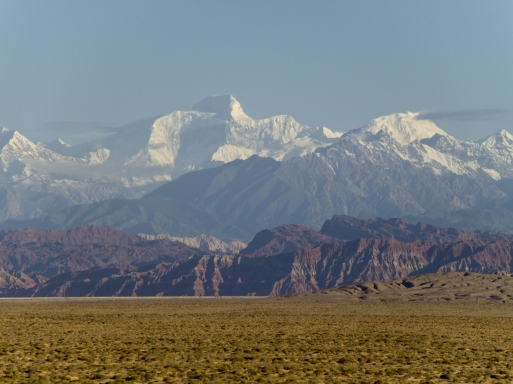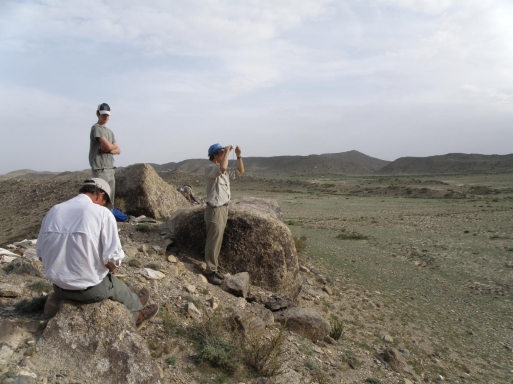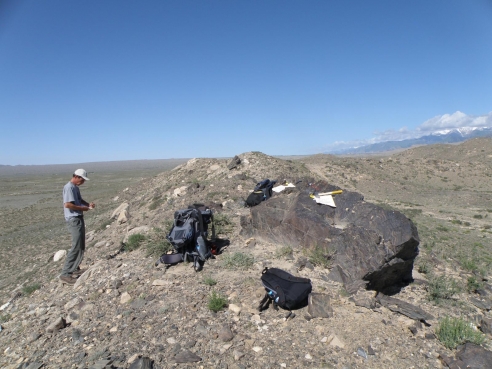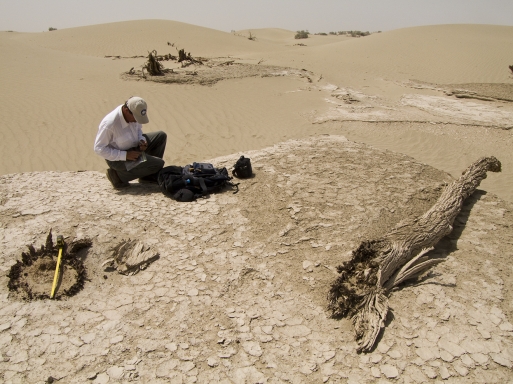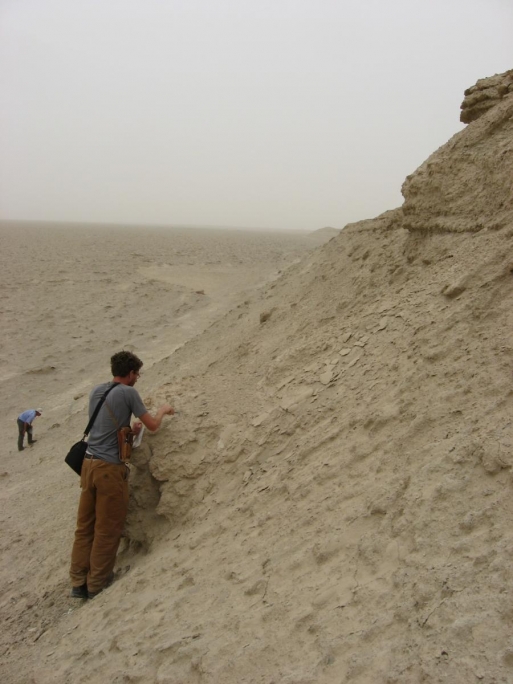Paleoclimate of Central Asia: Glacial geology and palaeohydrology of the Tarim Basin, Xinjiang, China
Tarim Basin, Xinjiang, China
Palaeoclimate of Central Asia: Glacial geology and palaeohydrology of the Tarim Basin, Xinjiang, China
Aaron E. Putnam, George H. Denton
Collaborators: Wally Broecker and Joerg Schaefer (Columbia University), David E. Putnam and Chunzeng Wang (University of Maine at Presque Isle), Peter and Fred Quesada (Fore River Company)
We ventured to Central Asia as a part of our global effort to resolve patterns of worldwide mountain glaciation since the last ice age. Major questions of climate dynamics are: (1) What causes global glacial cycles? (2) When Earth was most firmly in the grip of an ice age, why did it suddenly come to an end? The abrupt end of the last ice age is called the ‘last glacial termination’, and constitutes the great global warming of the last 100,000 yrs. Understanding ice ages and their terminations is essential for identifying the basic processes driving Earth’s climate today, and offers a key benchmark against which predictive climate models can be calibrated. Our goal is to determine how climate in both polar hemispheres was linked during the last ice age and the last glacial termination (see also our expedition pages covering our work on this subject in New Zealand and the Western United States). Very little is known about the glacial history of remote Central Asia, which lies on the opposite side of the Northern Hemisphere from the North Atlantic region and on the other side of the planet from our field sites in New Zealand and southern South America, and thus presents an opportunity to unravel climate linkages across these vast distances.In addition to studying the history of Earth’s glaciers, we are also interested in global patterns of past rainfall to gain insight into how Earth’s wind belts and monsoons have changed since the last ice age. This hydrological information goes hand-in-hand with the glacial record to allow a comprehensive reconstruction of the global climate system since the last glacial cycle, as well as during abrupt climate events that have occurred since the last ice age. Of equal importance is to acquire knowledge regarding the predicted response of human societies to Central Asian water availability to ongoing climate change and a warming world. Current predictions are highly uncertain as different climate models yield conflicting results. Because Central Asian societies receive most of their water from melting mountain ice and snow, empirical constraints on the relationship between water availability and past climate changes are essential to assess impacts of current and future climate changes on irrigation, agriculture and livestock in the dry latitudes of Central Asia today.We use glacial geochronology to reconstruct the history of Earth’s glaciers, which can then be used to infer patterns of past temperature changes. In particular, we use a revolutionary new dating method called ‘10Be surface-exposure dating’. This method relies on the buildup of ‘cosmogenic nuclides’ in quartz minerals found in rocks. This build-up is a consequence of cosmic ray bombardment, and cosmic rays can only bombard a rock’s surface when that surface is exposed to the sky. Thus, the number of cosmogenic atoms can be measured and the time since that surface was exposed to the sky can be quantified. Recent analytical improvements now allow us to date rock surfaces with a high level of accuracy.Using the 10Be method, we targeted a classic system of terminal moraines (mounds of debris deposited by the tongue of a previously enlarged glacier) along the southern flank of the Tien Shan, on the northern rim of the great Taklamakan Desert.In addition to sampling moraine boulders to reconstruct glacial history, we surveyed the landscape in and around the Taklamakan Desert where we discovered geological and biological evidence indicating that regions that are now desert were much wetter in the past. Understanding the hydrology of this part of Asia has not only implications for understanding global climate dynamics, but is also very important for being able to evaluate how water availability might change as the globe warms due to rising atmospheric CO2. Thus we collected samples for radiocarbon dating that shed light on a time when a vastly different climate existed in the Tarim Basin from that we know today. We hope that by knowing when these water-loving animals and plants grew, we can place the hydrological history of Central Asia into a global palaeoclimatic context and ultimately unravel how water availability in this region will respond to future climate change, and how quickly some of these changes might occur.
- Figure 1. Map of Tarim Basin, Xinjiang, Western China showing field areas in the Tien Shan mountains, Taklamakan and Lop Deserts.
- Figure 2. Google Earth satellite image of Pochengzi moraine belt. The moraines are the dark colored ridges set against lighter colored outwash deposits. These moraines have been attributed to the last glacial stage but the exact time of their formation is unknown. Deriving a glacier chronology from these moraines was the principle focus of our investigation.
- Figure 3. Photograph looking north toward the southern flank of the Tien Shan. (Photo: A. Putnam)
- Figure 4. Panorama of inner moraine ridge of the Pochengzi moraine system. (Photo: A. Putnam)
- Figure 5. Photo looking east along inner Pochengzi moraine ridge toward boulder sampled for surface-exposure dating. The gentleman using the clinometer (Peter Quesada) is mapping the horizon, so that we can later account for topographic shielding of cosmic radiation in our surface-exposure age calculations. Also pictured are Fred Quesada (left, standing) and David Putnam (sitting). (Photo: A. Putnam)
- Figure 6. Photograph of boulder embedded in the outermost Pochengzi moraine. This boulder was sampled for surface-exposure dating. Person in photo is David Putnam. (Photo: A. Putnam)
- Figure 7. Photograph of boulder sampled for surface-exposure dating on inner moraine belt. Curious Uyghur goat herders and their goats in background. (Photo: A. Putnam)
- Figure 8. Photograph looking north, up-valley toward the innermost moraine ridge featured in the foreground. People in photo are Aaron Putnam (pointing), Peter and Fred Quesada. (Photo: D. Putnam)
- Figure 9. Photograph of field team walking along the outermost Pochengzi moraine ridge. Right to left: Aaron Putnam, Chunzeng Wang, and Driver Zhao. (Photo: D. Putnam)
- aklamakan Desert. David Putnam is taking notes regarding a sample that we collected for radiocarbon dating. (Photo: A. Putnam)
- Figure 11. Photo of Bactrian camels walking along the southern limb of the Silk Road, between Khotan and Charklik. (Photo: A. Putnam)
- Figure 12. Photograph of Aaron Putnam investigating bluffs of ancient lake deposits that formed during a time when the Lop Desert was instead an inland sea. (Photo: C. Wang)
- Figure 13. Photograph of the desolate, ancient playa lake bed that characterizes the interior of the Lop Desert. (Photo: A. Putnam)




